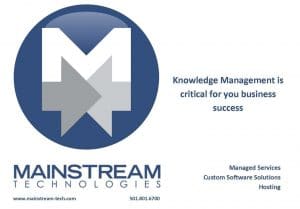 Creating an environment that institutional knowledge is available and accessible throughout the business improves your ability to make fact-based decisions.
Creating an environment that institutional knowledge is available and accessible throughout the business improves your ability to make fact-based decisions.
Have you ever walked into the office first thing in the morning and realized you needed some information for your meeting scheduled later in the day? You weren’t really sure where to get it, but you knew who did.
Have you ever lost a long-term coworker who knew everything, not only about their own job but about yours too?
Every business has someone who’s been around for a while and knows how to get the job done without a fuss. Their years of experience help them avoid the pitfalls that surround us all. Their effectiveness makes life easier for all of us. There’s no substitute for experience.
So many times this real-world experience is underappreciated and is actually one of our most valuable assets. What if you could create an environment where all your business information and experiences were available to everyone who needed it?
This is the underlying concept of Knowledge Management (KM) which is the process of capturing, developing, sharing, and effectively using organizational knowledge. It’s an effort to achieve business objectives by making the best use of knowledge and real-world experience that you have and continue to develop.
KM draws from all levels of the business (the people, the processes, your providers and the technology). It’s shared throughout the enterprise to preserve your business intelligence and stimulate new ideas that create business improvements.
Benefits
The benefit of cultivating KM is preserving and leveraging a hard-earned institutional asset and offers the potential to:
- Reduce the impact of employee turnover,
- Encourage the free flow of ideas to foster innovation,
- Improve the quality of decision making and service quality,
- Boost revenue by accelerating time to market for products and services,
- Enhance employee retention by demonstrating and rewarding them for their knowledge,
- Reduce operating costs by streamlining processes.
If you’re considering cultivating a KM initiative, don’t forget that your external vendors, partners and/or providers often have keen insight into your business. Their ‘outsider’s’ view often proves to be just as valuable as an insider’s view.
How do you get started?
One of the best resources we’ve found for exploring the possibility of implementing a KM strategy can be found on Head Start’s website. They’ve consolidated a lot of information about KM and developed a concise strategy for getting started.
They recommend that the first step is to develop an informal strategy document that identifies:
Challenges/Goals to the business
What are your business goals and the challenges that are between you and achieving that goal? How do you think KM will help you achieve that goal?
Where are you now?
How does your lack of a KM practice affect your ability to meet these goals? How does KM’s absence affect your team’s effectiveness? How does your current structure (culture) enable or impede a good KM practice?
Where you’d like to be?
Outline what you anticipate the benefits will be for a KM practice. How will it help you achieve your goals? What is your vision of a successful KM practice? Once you begin a KM practice, how will you measure progress and success?
How do you get there?
Create an action plan addressing the three key elements; people, process, and technology. What are the tools and processes you’ll use and how will you encourage buy in. The action plan should be detailed and include required resources, deliverables, and responsibilities.
Retaining, preserving and providing access to your institutional knowledge can benefit your organization by improving service quality, streamlining business processes and improving decision making.
If you’d like more information about how KM might help your organization, please contact us @ 501.801.6700 or visit our website at www.mainstream-tech.com.
###






